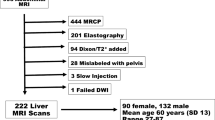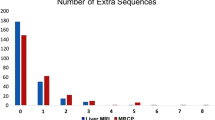Abstract
Purpose
To evaluate the effect of English proficiency on abdominal MRI imaging quality.
Methods
Three equal-sized cohorts of patients undergoing 3T abdominal MRI were identified based on English proficiency as documented in the EMR: Primary language of English; English as a second language (ESL)/no translator needed; or ESL, translator needed (42 patients per cohort for total study size of 126 patients). Three radiologists independently used a 1–5 Likert scale to assess respiratory motion and image quality on turbo spin-echo T2WI and post-contrast T1WI. Groups were compared using Kruskal–Wallis tests.
Results
For T2WI respiratory motion, all three readers scored the Translator group significantly worse than the English and ESL/no-Translator groups (mean scores across readers of 2.98 vs. 3.58 and 3.51; p values < 0.001–0.008). For T2WI overall image quality, all three readers also scored the Translator group significantly worse than the English and ESL/no-Translator groups (2.77 vs. 3.28 and 3.31; p values 0.002–0.005). For T1WI respiratory motion, mean scores were not significantly different between groups (English: 4.14, ESL/no-Translator: 4.02, Translator: 3.94; p values 0.398–0.597). For T1WI overall image quality, mean scores also were not significantly different (4.09, 3.99, and 3.95, respectively; p values 0.369–0.831).
Conclusion
Abdominal MR examinations show significantly worse T2WI respiratory motion and overall image quality when requiring a translator, even compared with non-translator exams in non-English primary language patients. Strategies are warranted to improve coordination among MR technologists, translators, and non-English speaking patients undergoing abdominal MR, to ensure robust image quality in this vulnerable patient population.


Similar content being viewed by others
References
Shin HBO, J. M.;. Language Projections 2010-2020. Federal Forecasters Conference.
Language Spoken at Home by Ability to Speak English for the Population 5 Years and Over. U.S. Census Bureau. [Available from: https://factfinder.census.gov/faces/tableservices/jsf/pages/productview.xhtml?pid=ACS_17_5YR_B16001&prodType=table.
John-Baptiste A, Naglie G, Tomlinson G, Alibhai SM, Etchells E, Cheung A, et al. The effect of English language proficiency on length of stay and in-hospital mortality. J Gen Intern Med. 2004;19(3):221-8.
Karliner LS, Jacobs EA, Chen AH, Mutha S. Do professional interpreters improve clinical care for patients with limited English proficiency? A systematic review of the literature. Health Serv Res. 2007;42(2):727-54.
Huang SY, Seethamraju RT, Patel P, Hahn PF, Kirsch JE, Guimaraes AR. Body MR Imaging: Artifacts, k-Space, and Solutions. Radiographics. 2015;35(5):1439-60.
Constable RT. MR physics of body MR imaging. Radiol Clin North Am. 2003;41(1):1-15, v.
Rosenkrantz AB, Bennett GL, Doshi A, Deng FM, Babb JS, Taneja SS. T2-weighted imaging of the prostate: Impact of the BLADE technique on image quality and tumor assessment. Abdom Imaging. 2015;40(3):552-9.
Chandarana H, Feng L, Block TK, Rosenkrantz AB, Lim RP, Babb JS, et al. Free-breathing contrast-enhanced multiphase MRI of the liver using a combination of compressed sensing, parallel imaging, and golden-angle radial sampling. Invest Radiol. 2013;48(1):10-6.
Betancourt JR, Tan-McGrory A, Flores E, Lopez D. Racial and Ethnic Disparities in Radiology: A Call to Action. J Am Coll Radiol. 2019;16(4 Pt B):547-53.
ACR–SAR–SPR PRACTICE PARAMETER FOR THE PERFORMANCE OF MAGNETIC RESONANCE IMAGING (MRI) OF THE LIVER. Reston, VA.2015 [Available from: https://www.acr.org/-/media/ACR/Files/Practice-Parameters/MR-Liver.pdf.
ACR–SAR–SPR PRACTICE PARAMETER FOR THE PERFORMANCE OF MAGNETIC RESONANCE IMAGING (MRI) OF THE ABDOMEN (Excluding the Liver). Reston, VA. 2015 [Available from: https://www.acr.org/-/media/ACR/Files/Practice-Parameters/MR-Abd.pdf?la=en.
Zaitsev M, Maclaren J, Herbst M. Motion artifacts in MRI: A complex problem with many partial solutions. J Magn Reson Imaging. 2015;42(4):887-901.
Author information
Authors and Affiliations
Corresponding author
Additional information
Publisher's Note
Springer Nature remains neutral with regard to jurisdictional claims in published maps and institutional affiliations.
Rights and permissions
About this article
Cite this article
Taffel, M.T., Huang, C., Karajgikar, J.A. et al. Retrospective analysis of the effect of limited english proficiency on abdominal MRI image quality. Abdom Radiol 45, 2895–2901 (2020). https://doi.org/10.1007/s00261-020-02433-6
Published:
Issue Date:
DOI: https://doi.org/10.1007/s00261-020-02433-6




